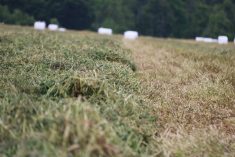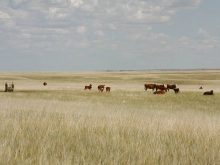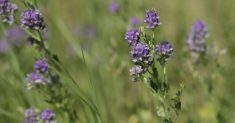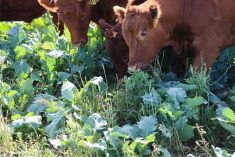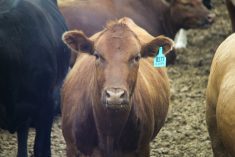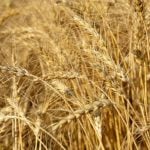I call it my ‘big red swather,’” Brian Harper told a group of cattle producers visiting his farm near here last August.
Harper smiled and as if on cue, 63,550 lbs. of his herd of Shaver Beefblend/Lincoln Red cattle started munching their way down one of his field’s narrow one-acre grazing paddocks.
“Up to 2013, we had 16 plots that we moved the cattle around on. This allowed 45 to 60 days of rest for each of the plots to recover from the grazing until next rotation,” said Harper, who runs his forage-only, purebred operation Circle H Farms with his wife Sonja. “This year, we switched to the high stock density system for grazing and are moving our herd among 128 one-acre plots within the old 16-paddock system, allowing 127 days rest for each plot.”
Read Also
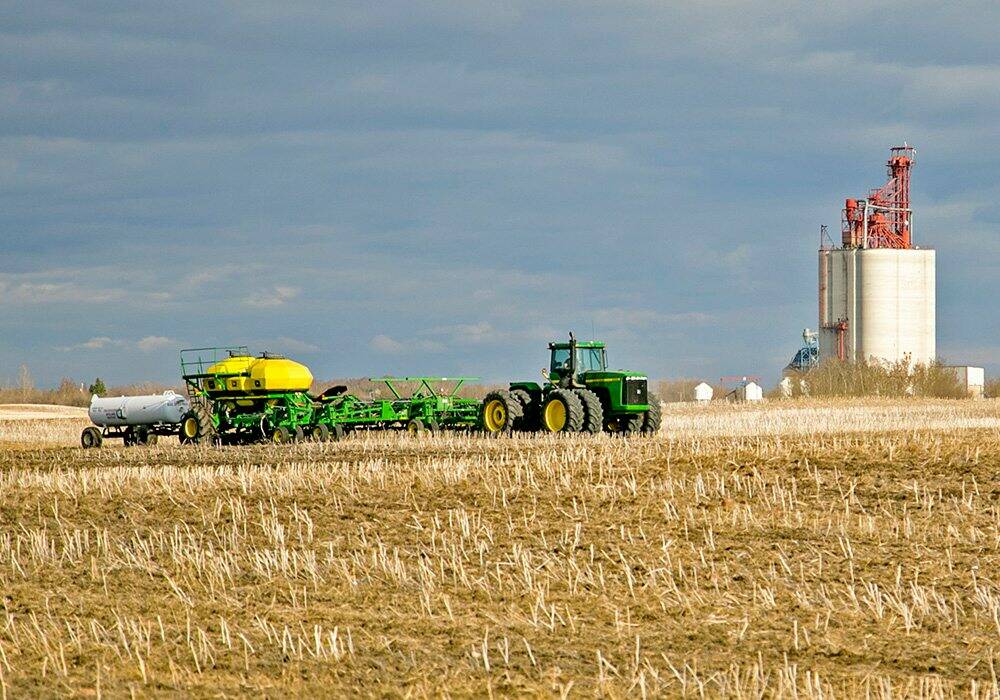
Better data on fertilizer emissions with the Internet of Things
Web of soil sensors looks for live insights on farm greenhouse gas emissions and nitrogen fertilizer application.
Harper says the movement of his herd from paddock to paddock is done by use of an automatic gate opener called a Batt latch, a solar-powered, self-contained unit that is set to open at a time and date that he chooses.
“The benefits to our herd, the grass, the soil and the environment have been substantially noticeable,” Harper said. “On the business side, we doubled the carrying capacity as we were only half done the pasture at the time of year when in past years we were generally through it already once. This would be the big factor for most producers as there is more return per acre.”
Harper was joined by Neil Dennis, an experienced mob grazier from Wawota, Sask., who was brought in by organizers to help showcase the high stock density grazing systems as a viable economic and environmental option for cattle producers.

The tour of Harper’s mob-grazing system was funded by the federal government’s Commission of Environmental Cooperation (CEC) as part of an 18-month agreement with the Manitoba Forage and Grassland Association (MFGA). The aim is to implement and promote ranch-level beneficial management practices (BMPs) that improve environmental and economic sustainability of livestock production.
“The CEC has collaborated in protecting North America’s environment in the United States, Canada and Mexico through the North American Agreement on Environmental Cooperation,” said MFGA executive director Wanda McFadyen. She quarterbacked the larger agreement with CEC that has similar events planned in Saskatchewan and Alberta. “When CEC connected with us about Prairie forages and grasslands and the beef industry, we felt it was an excellent fit to showcase the environmental stewardship that producers such as the Harpers provide to Manitobans as well as their economic savvy as business people in the cattle industry.”
- From the Alberta Farmer Express: Vermilion ranch honoured with TESA environmental ward
Local partner
With the CEC agreement in place, MFGA turned to Manitoba Grazing Clubs, a longtime partner, to organize the event. Grazing club co-ordinator Michael Thiele suggested the Harpers — with Dennis in support — as excellent candidates to anchor the half-day tour.
“These two producers are strong advocates for grazing systems and they are extremely well respected by other producers,” said Thiele, a contracted employee of Ducks Unlimited Canada (DUC). “The narrow width of the paddocks means the cattle work it hard back and forth, what they don’t graze they stomp down, which enables the regeneration of forages during rest.”
Thiele refers to the high stock density grazing system as “biological agriculture,” as he says the principles of biology are being applied to healthy, high-quality food production. He quickly lists off benefits such as soil health, range health, biodiversity, carbon capture and critical wildlife habitat that the narrow paddocks provide within the scheduled rotation.
In addition to the paddock with Harper’s “big red swather,” the tour made three other stops to highlight the benefits of areas that were currently being rested or had been established with cicer milk vetch. Harper pointed out the excellent vegetation health, the high sugar content in the forage and lack of bare ground spots above the soil.
“Most pastures are high nutrients and low sugar,” said Dennis. “The healthier the soil, the healthier the plant, the higher the sugar content in the plant will be and the more nutritious it will be for the cattle. Also, with the more nutrient-dense plants, they are better able to withstand frost as they get started earlier and last longer.”
The action below the surface drew just as much of the tour’s attention as the visible action above.
“Look at the soil armour,” Dennis said as he and Harper hovered over a fresh spadeful of soil and grass. “A deep healthy root system like this really benefits soil erosion and is excellent for increasing the water-holding capacity of the soil so the water is not running off and increasing erosion or adding to floods.”
The soil is where the Harpers have focused their attention as they pursue healthy, high-quality, nutrient-dense food.
“We believe that everything we are and everything we eat has come from the soil either directly or indirectly,” said Brian Harper. “With this system, there is also the benefit of improved soil health which may not seem an economic return in the short term. However, I believe that in the future as the soil health improves, there will be even more grass. As stock density goes up everything keeps getting better, but only if the proper rest period is allowed. Rest is the key!”



